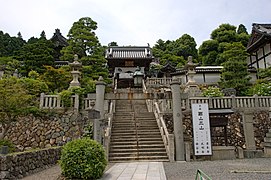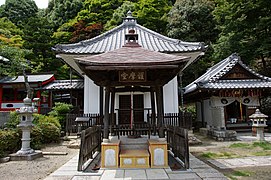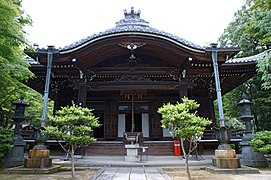Yokoku-ji
The Yōkoku-ji ( Japanese 楊 谷 寺 ), also known as Yanagitani-Kannon ( 柳 谷 観 音 ), is a temple of the Nishiyama branch ( 西山 派 ) of the Jōdo direction of Buddhism in Nagaokakyō in Kyōto Prefecture . It has long been known for its healing waters and more recently for its azalea garden. It is the 17th temple on the New Saigoku Pilgrimage Route .
history
In 806, high priest Enchin of Kiyomizu-dera in Kyoto is said to have laid out the temple. Priest Kūkai came here in 811 and found the spring whose water, called Okōzui ( 独 鈷水), helps people with eye diseases.
The attachment
At the foot of the temple on the mountain, the beginning of the pilgrimage path ( 参 道 Sandō ) is marked with a stone lantern on the right and left. There is a Jizō ( 地 蔵 ) with the inscription "From Yanagitani from 18 Chō" ( 柳 谷 是 よ り 十八 丁 Yanagitani-ze yori jūhachi chō ). The path is then marked with a stone for each Chō (= 109 m). After seven chō you come to a fork, from where the path branches off to Jōdotani village. On the way to the temple there are 13 Mirokudani Buddhas ( 弥勒 谷 十三 仏 ) made of stone. Most are 70 to 100 cm high and are made of natural stone. Since the Edo period there have been followers of the belief that the thirteen Buddhas comfort the deceased and pray for admission to paradise. Then you reach the "willow tree valley" ( 柳 谷 Yanagidani ) called area with the temple complex.
In front of the temple there are a few inns where you can stay overnight. From there a stone staircase leads to the simple temple gate ( 山門 Omote-mon ; 1 in the plan), which is designed as a four-legged gate . For the construction of the temple, the mountain slope was designed into a stepped terrace, similar to a stepped gallery for setting up dolls, the Hinadan ( 雛 壇 ) used for the Hina-Matsuri .
Ahead you can see the main hall ( 本 堂 Hondō ; 2). There the main cult figure, a 1000-armed Kannon ( 木造 千手 観 音 立 像 Mokuzō senju Kannon ritsuzō ), made of wood, the "Yanagidani-Kannon", is worshiped. Together with the water, it should help with diseases of the eyes. On the left you have the abbot and monk's area (A) with dining room ( 庫裏 Kuri ) and abortive residence ( 書院 Shoin ), on the right is the Amida Hall ( 阿 弥陀 堂 ; 3). A small pavilion ( 地 蔵 堂 ; 5) is dedicated to the holy Jizō . Behind, higher up, you can find the Oku-no-in ( 奥 の 院 ; 4).
Behind the hall, Yōkokuji Park has been famous since the Edo period, especially for its azaleas.
photos
Remarks
- ↑ 独 鈷 , usually read dokko , is the thunderbolt with two ends in esoteric Buddhism.
literature
- Kyoto-fu rekishi isan kenkyukai (Ed.): Yōkoku-ji . In: Kyoto-fu no rekishi sampo (ge). Yamakawa Shuppan, 2011. ISBN 978-4-634-2 4826-7 . P. 19.
Web links
Coordinates: 34 ° 54 ′ 51.6 " N , 135 ° 39 ′ 9.7" E








